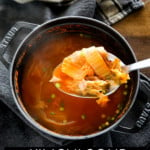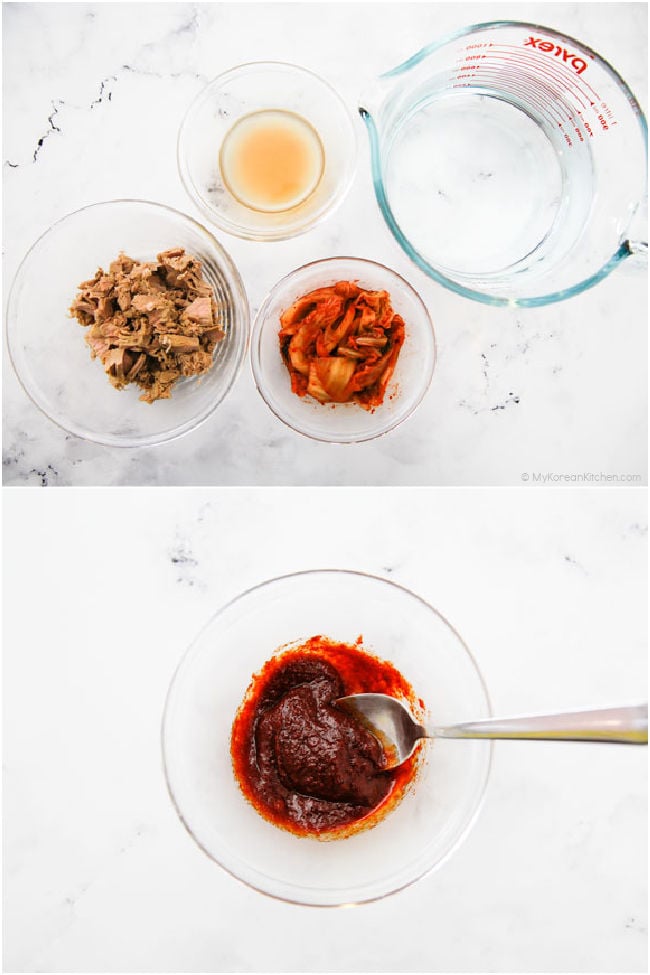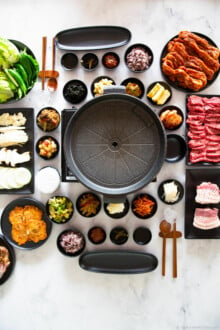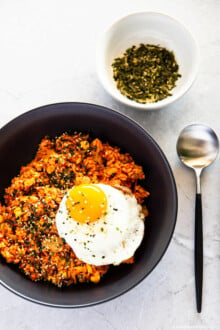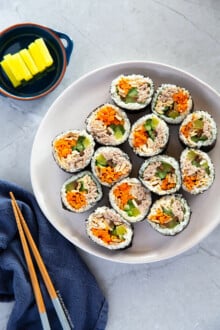Light, refreshing and delightful kimchi soup recipe.
What is Kimchi Soup
Kimchi soup (kimchi guk, 김치국) is a staple Korean soup made with kimchi.
The name of kimchi soup can vary based on other ingredients you put in the soup. Today’s kimchi soup recipe includes canned tuna, making this soup’s name tuna kimchi soup (chamchi kimchi guk, 참치 김치국).
While this kimchi soup may not look fancy, it is so refreshing and delicious. It’s also very easy to make and budget friendly.
My Best Cooking Tips
While kimchi soup is so easy to make, I have my secret that will make this soup even better.
- Spring water from canned tuna – Most canned tuna comes packed in either spring water or oil and I normally discard this when I cook. However, I learnt while experimenting with this recipe that you can get better tasting; more flavor intensified soup by using this water or oil. So be sure to save some water or oil as you drain the tuna. As I prefer lighter and more refreshing taste, I used canned tuna from spring water. However, if all you have is canned tuna packed in oil, you can use that as well.
- Simmering the soup “long enough” – To bring out more depth of kimchi flavor, be sure to simmer the soup long enough (15 to 20 minutes) over medium low heat once the soup is rolling boiling. All ingredients will be cooked and the soup is still edible without boiling for this long, but the soup will taste better if you simmer a bit longer.
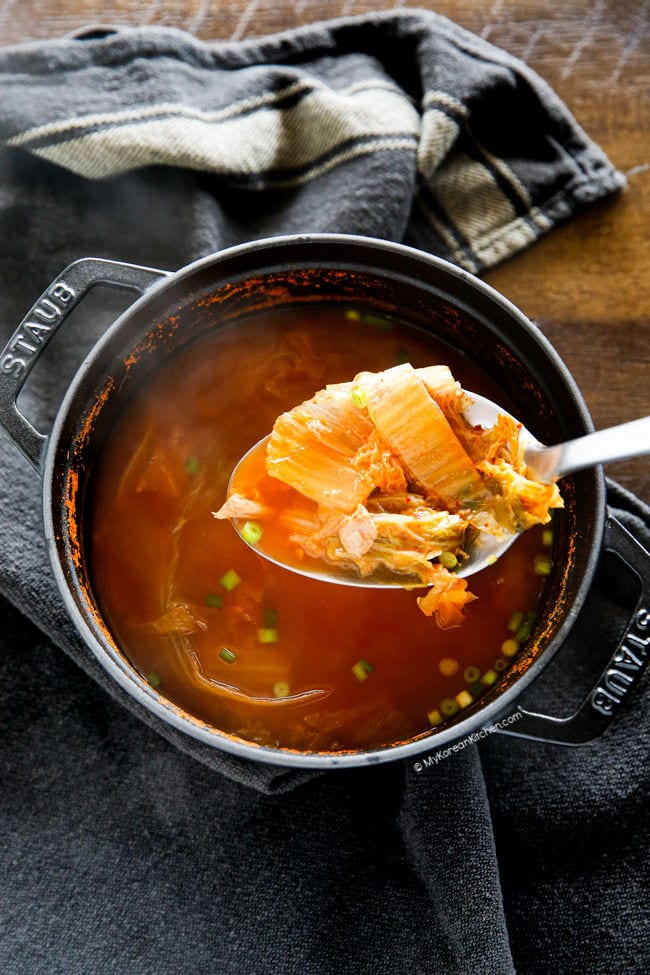
Similar Recipes with Kimchi Soup
Over the years, I have shared a few different ways to make kimchi soup or stew. Check out my other recipes below and try them. Each will give you a different taste and sensation.
- Kimchi Jjigae (Kimchi stew)
- Slow Cooker Kimchi Beef Stew
Also, if you have too much kimchi and don’t know what to do with it, check out my how to eat kimchi post. There you will find 14 different ways you could use your kimchi.
How to Store Kimchi Soup
If you have leftover kimchi soup, you can refrigerate it in an air tight container for 2 to 3 days. Alternatively, you can portion it and freeze for up to 3 months. (This is when the soup doesn’t contain tofu as with this kimchi soup recipe. Freezing tofu and thawing it can affect the texture of tofu.)
You can reheat the soup in a microwave or on the stove.
Ingredients for Kimchi Soup with Tuna, Serves 2-3
MAIN
- 1/2 cup kimchi, at least 2 to 3 weeks old, cut into bite size pieces if not already
- 3 Tbsp water, drained from canned tuna
- 3 cups water
- 1 canned tuna (chunk style), 185g /6.5 ounces
SAUCE
- 1/2 Tbsp Korean soup soy sauce (gukganjang) or regular kikkoman soy sauce
- 1/2 Tbsp Korean fish sauce
- 1/2 Tbsp raw sugar
- 1 Tbsp Korean chili powder
- 1/2 Tbsp kimchi juice – this liquid is from the bottom of the kimchi container
GARNISH (OPTIONAL)
- 10g / 0.4 ounces green onion, thinly sliced
- fine sea salt, to taste
*1 Tbsp = 15ml, 1 cup = 250ml
** If you want to learn more about Korean ingredients, check my essential Korean cooking ingredients list.
How to Make Kimchi Soup with Tuna
1. Pre heat a medium pot over medium heat (about 20 seconds). Add the kimchi and tuna drained water. Stir them well until the kimchi is partly cooked (about 2 mins).
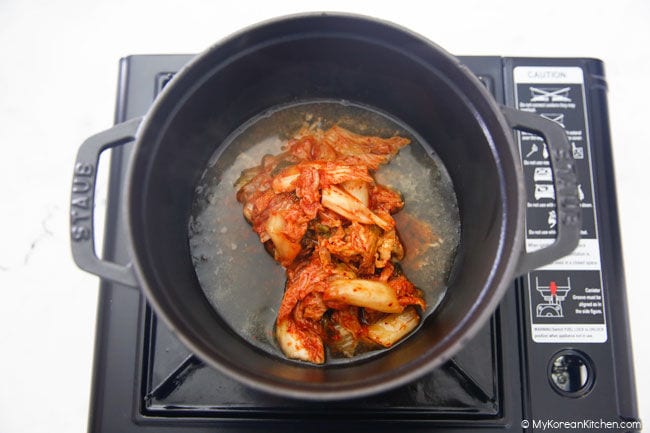
2. Add the water and the sauce. Cover the pot and boil over medium high heat. When the water is rolling boil, add the tuna without stirring it too much so as to not to break up the tuna. (It presents better when the tuna isn’t flaked off too much when you serve.)
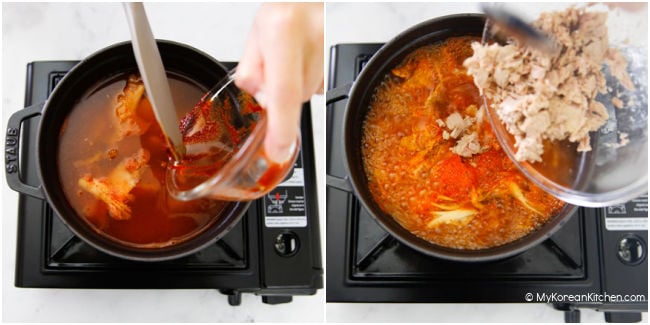
3. Reduce the heat to medium low, cover the pot and boil for a further 15-20 minutes.
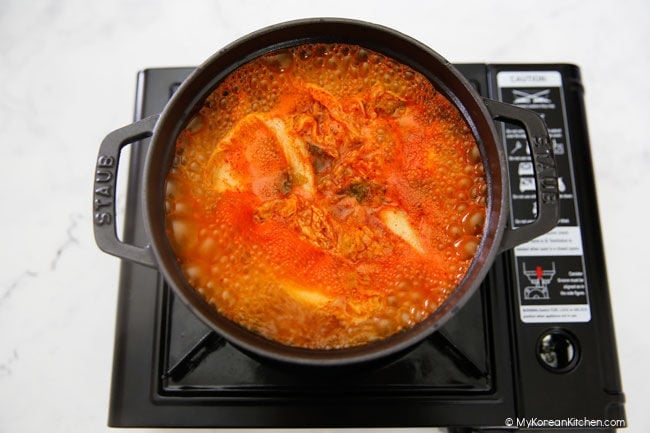
4. Garnish with green onions and season with salt, if required. Serve with a bowl of rice, kimchi and other Korean side dishes.
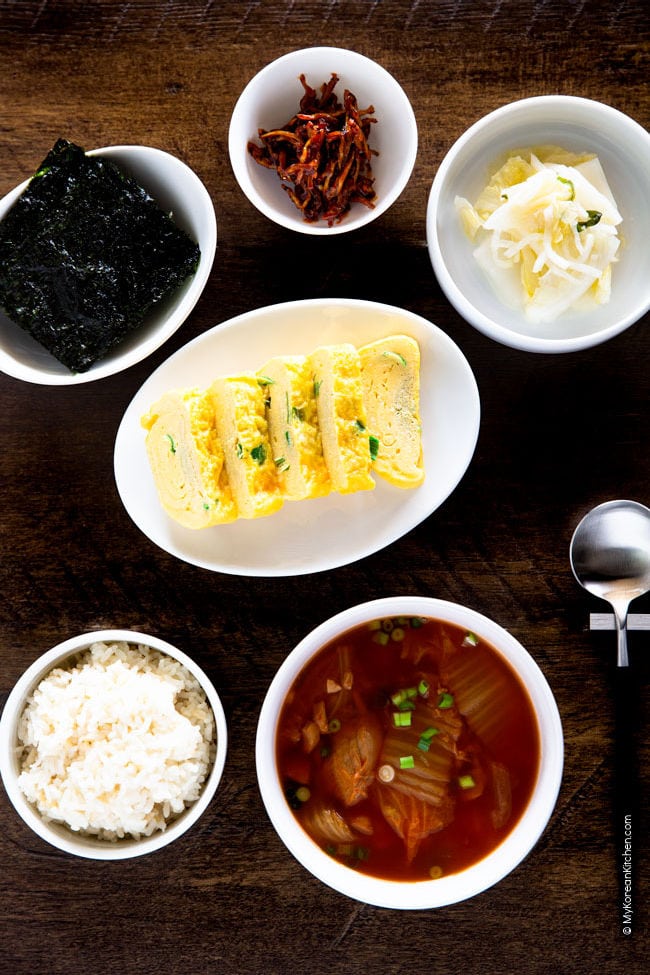
Love Korean food? Browse lots more Korean recipes from my easy Korean recipe collections. And subscribe to my newsletter and follow along on Facebook, Pinterest and Instagram for all of the latest updates.
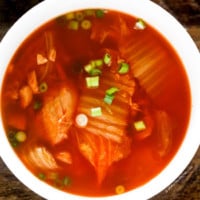
Ingredients
MAIN
- 1/2 cup kimchi , at least 2 to 3 weeks old, cut into bite size pieces if not already
- 3 Tbsp water , drained from canned tuna
- 3 cups water
- 185 g canned tuna (6.5 ounces), chunk style
SAUCE
- 1/2 Tbsp Korean soup soy sauce or regular kikkoman soy sauce
- 1/2 Tbsp Korean fish sauce
- 1/2 Tbsp raw sugar
- 1 Tbsp Korean chili powder
- 1/2 Tbsp kimchi juice , this liquid is from the bottom of the kimchi container
GARNISH (OPTIONAL)
- 10 g green onion (0.4 ounces), thinly sliced
- fine sea salt , to taste
Instructions
- Pre heat a medium pot over medium heat (about 20 seconds). Add the kimchi and tuna drained water. Stir them well until the kimchi is partly cooked (about 2 mins).
- Add the water and the sauce. Cover the pot and boil over medium high heat. When the water is rolling boil, add the tuna without stirring it too much so as to not to break up the tuna. (It presents better when the tuna isn’t flaked off too much when you serve.)
- Reduce the heat to medium low, cover the pot and boil for a further 15-20 minutes.
- Garnish with green onions and season with salt, if required. Serve with a bowl of rice, kimchi and other Korean side dishes.
Notes
- 1 Tbsp = 15ml, 1 cup = 250ml
- If you want to learn more about Korean ingredients, check my essential Korean cooking ingredients list.
Nutrition Info (per serving)
The nutrition information shown is an estimate provided by an online nutrition calculator. It should not be considered a substitute for a professional nutritionist’s advice.
